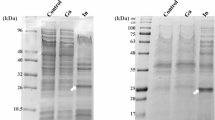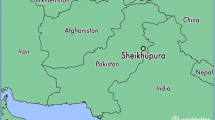Abstract
The current study describes the isolation and characterization of E. coli from wastewater that collected from El-Malah canal in Assiut, Egypt. Twelve isolates were investigated for heavy metal resistance by which one of them showed multiple metal resistances. Furthermore, the bacterium was identified as E. coli ASU3 according to biochemical tests and then, preserved at Assuit University Mycological Centre with accession number AUMC B83. It exhibited high minimal inhibitory concentrations for metals and antibiotic resistance. The order of metals toxicity to the bacterium was Cr6+ > Cu2+ > Co2+ > Pb2+ > Ni2+ > Cr3+ > Cd2+ > Zn2+. Total protein content of E. coli ASU3 decreased with the increase of copper concentration. Under exposure of different concentrations of copper, the induction of antioxidant enzymes such as catalase, peroxidase and ascorbate peroxidase was increased and these antioxidant enzymes can contribute to combating oxidative stresses.

Similar content being viewed by others
Abbreviations
- CAT:
-
Catalase
- POX:
-
Peroxidase
- APOX:
-
Ascorbate peroxidase
- ROS:
-
Reactive oxygen species
- SOD:
-
Superoxide dismutase
- MIC:
-
Minimal inhibitory concentration
- Cu:
-
Copper
- EC:
-
Electrical conductivity
- COD:
-
Chemical oxygen demand
- BOD:
-
Biochemical oxygen demand
- MPN:
-
Most probable number
- EMB:
-
Eosin methylene blue
- R:
-
Resistance
- S:
-
Sensitive
- MTC:
-
Maximum tolerance concentration
References
Abassi NA, Kushad MM, Endress AG (1998) Active oxygen scavenging enzyme activities in developing apple flowers and fruits. Sci Hortic 74:183–184
APHA (1995) Standard methods for the examination of water and wastewater, 19th edn. American Public Health Association, Washington DC
Banat K, Howari F, Al-Hamada A (2005) Heavy metals in urban soils of central Jordan: should we worry about their environmental risks? Environ Res 97:258–273
Bauer AW, Kirby WMM, Sherris JC, Turck M (1966) Antibiotic susceptibility testing by a standardized single disc diffusion method. Am J Clin Pathol 45:493–496
Brenner DJ, Krieg NR, Staley JT, Garrity GM (2005) Bergey’s manual of systematic bacteriology volume two: the proteobacteria part C. Springer, Berlin
Cakmak I, Marschner H (1992) Magnesium deficiency and high light intensity enhance activities of superoxide dismutase, ascorbate peroxidase, and glutathione reductase in bean leaves. Plant Physiol 98:1222–1227
Chaoui SM, Ghorbal MH, El-Ferjani E (1997) Cadmium and zinc induction of lipid peroxidation and effects on antioxidant enzyme activities in bean (Phaseolus vulgaris L.). Plant Sci 127:139–147
Dalton DA, Hanus FJ, Russell SA, Evans HJ (1987) Purification, properties and distribution of ascorbate peroxidase in legume root nodules. Plant Physiol 83:789–794
Fernandes D, Potrykus J, Morsiani C, Raldua D, Lavado R, Cinta P (2002) The combined use of chemical and biochemical markers to assess the water quality in two low-stream rivers (NE Spain). Environ Res 90:169–178
Filho WD, Toress MA, Tribess TA, Pedrosa RC, Soares CHL (2001) Influence of season and pollution on the antioxidant defenses of the cichlid fish acara (Geophagus brasiliensis). Braz J Med Biol Res 34:719–726
Gadd G (1992) Metals and microorganisms: a problem of 161 definition. FEMS Microbiol Lett 100:197–204
Gao S, Yan R, Cao M, Yang W, Wang S, Chen F (2008) Effects of copper on growth, antioxidant enzymes and phenylalanine ammonia-lyase activities in Jatropha curcas L. seedling. Plant Soil Environ 54:117–122
Gaspar T (1991) Biochemical, molecular and physiological aspects of plant peroxidases. University M. Curie Sklodowska, Poland, pp 249–280
Hassan SHA, Abskharon RNN, Gad El-Rab SMF, Shoreit AAM (2008) Characterization of heavy metal resistant strain Pseudomonas aeruginosa isolated from polluted sites in Assiut, Egypt. J Basic Microbiol 48:168–176
Hassen A, Saidi N, Cherif M, Boudabous A (1998) Resistance of environmental bacteria to heavy metals. Bioresour Technol 64:7–15
Imlay JA, Linn S (1988) DNA damage and oxygen radical toxicity. Science 240:1302–1309
Kappus H (1987) Oxidative stress in chemical toxicity. Arch Toxicol 60:144–149
Ledin M (2000) Accumulation of metals by microorganisms-processes and importance for soil systems. Earth Sci Rev 51:1–31
Lee MY, Shin HW (2003) Cadmium-induced changes in antioxidant enzymes from the marine alga Nannochloropsis oculata. J Appl Phycol 15:13–19
Lowry OH, Rosebrough NH, Farr AL, Randall RJ (1951) Protein measurement with the folin phenol reagent. J Biol Chem 193:291–297
MacFaddin J (1985) Media for isolation-cultivation-identification-maintenance of medical bacteria. Williams and Wilkins, Baltimore, pp 1–27
Malik A, Jaiswal R (2000) Metal resistance in Pseudomonas strains isolated from soil treated with industrial wastewater. World J Microbiol Biotechnol 16:177–182
Mergeay M (1995) Heavy metal resistance in microbial ecosystems. Mol Microb Ecol Man 6:7–17
Nies DH (1999) Microbial heavy-metal resistance. Appl Microbiol Biotechnol 51:730–750
Pal A, Choudhuri P, Dutta S, Mukherjee PK, Paul AK (2004) Isolation and characterization of nickel-resistant microflora from serpentine soils of Andaman. World J Microbiol Biotechnol 20:881–886
Pilon M, Abdel-Ghany SE, Cohu CM, Gogolin KA, Ye H (2006) Copper cofactor delivery in plant cells. Curr Opin Plant Biol 9:256–263
Piotrowska-Seget Z, Cycon M, Kozdroj J (2005) Metal-tolerant bacteria occurring in heavily polluted soil and mine soil. Appl Soil Ecol 28:237–246
Shah K, Kumar GR, Verma S, Dubey SR (2001) Effect of cadmium on lipid peroxidation, superoxide anion generation and activities of antioxidant enzymes in growing rice seedlings. Plant Sci 16:1135–1144
Sigler K, Chaloupka J, Brozmanova J, Stadler N, Hofer M (1999) Oxidative stress in microorganisms, microbial vs. higher cells-damage and defenses in relation to cell aging and death. Folia Microbiol 44:587–624
Soltan EM (2001) Isolation and characterization of antibiotic and heavy metal resistant Pseudomonas aeruginosa from different polluted waters in Sohag Distrit, Egypt. Microbiol Biotechnol 11:50–55
Spain A (2003) Implications of microbial heavy metal resistance in the environment. Rev Undergrad Res 2:1–6
Unaldi MN, Korkmaz H, Arikan B, Coral G (2003) Plasmid-encoded heavy metal resistance in Pseudomonas sp. Bull Environ Contam Toxicol 71:1145–1150
Whiteley CG, Lee DJ (2006) Enzyme technology and biological remediation. Enzym Microb Technol 38:291–316
WHO (World Health Organization) (2005) Guidelines for drinking-water quality, vol 1. WHO, Geneva
Yilmaz EI (2003) Metal tolerance and biosorption capacity of Bacillus circulans strain EB1. Res Microbiol 154:409–415
Zhang J, Kirkham BM (1994) Drought-stress induced changes in activities of superoxide dismutase, catalase and peroxidase in wheat species. Plant Cell Physiol 35:785–791
Zhang FQ, Wang YS, Lou ZP, Dong JD (2007) Effect of heavy metal stress on antioxidative enzymes and lipid peroxidation in leaves and roots of two mangrove plant seedlings (Kandelia candel and Bruguiera gymnorrhiza). Chemosphere 67:44–50
Acknowledgments
We thanks Mr. Yasser M. Awad for his valuable help, critical reading of this manuscript and helpful discussions. The authors are grateful to the precious comments and careful correction made by anonymous reviewers for further improvements of this manuscript.
Author information
Authors and Affiliations
Corresponding author
Rights and permissions
About this article
Cite this article
Abskharon, R.N.N., Hassan, S.H.A., Kabir, M.H. et al. The role of antioxidants enzymes of E. coli ASU3, a tolerant strain to heavy metals toxicity, in combating oxidative stress of copper. World J Microbiol Biotechnol 26, 241–247 (2010). https://doi.org/10.1007/s11274-009-0166-4
Received:
Accepted:
Published:
Issue Date:
DOI: https://doi.org/10.1007/s11274-009-0166-4




